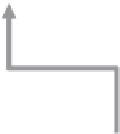Environmental Engineering Reference
In-Depth Information
remove contaminants from soil and sediments by physical and/or chemical techniques.
Soil washing involves the addition of a solution with the contaminated soil to transfer the
contaminants to the wash solution. It is most appropriate for weaker bound metals in the
form of hydroxides, oxides, and carbonates. Mercury, lead, cadmium, copper, nickel, zinc,
and chromium can be recovered by electrochemical processes if the levels of organic com-
pounds are not signiicant. Metals can also be removed from precipitation or ion exchange.
Precipitation is not applicable for metal sulides. Pretreatment to remove uncontaminated
coarser fractions can be used. Various additives can be employed such as bases, surfactants,
acids, or chelating agents. Nitric, hydrochloric, and sulfuric acids can be used. However,
if sulfuric acid is used, 50% of the amount is required compared with hydrochloric acid
(Papadopoulos et al., 1997).
Figure 11.4 illustrates a typical soil washing process where the separation consists of size
separation, washing, rinsing, and other technologies similar to those used in the mineral
processing industry. Larger particles are separated from the smaller ones as they have
lower contamination levels. The smaller volumes of soil can be treated less expensively.
Surfactants may be added in the washing water. The more contaminated size range is
0.24 to 2 mm due to the surface charges of the soil clay particles that attract anionic metal
contaminant and the organic fraction that binds organic contaminants. Wash water and
additives should be recycled, or treated prior to disposal. The mechanical dewatering of
particles is performed via a ilter press, conveyer iltration, centrifugal separation, or froth
lotation by the introduction of air bubbles in to the slurry (Venghuis and Werther, 1998).
Coarse materials
Washing and Sieving
Washing and Sieving
Fine particles
settling
Soil or
dredged
materials
Screening
Screening
Disposal
Waste for disposal
or reuse
FIGURE 11.4
Size separation and washing of excavated and dredged materials.











































Search WWH ::

Custom Search